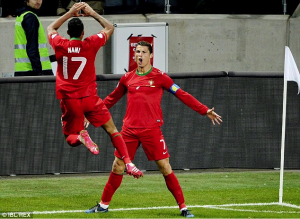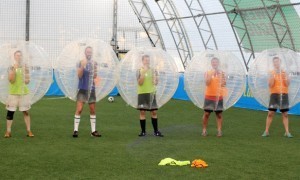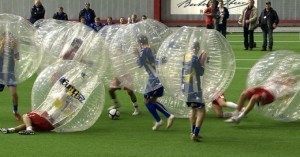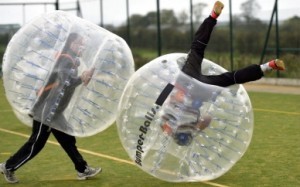Laurent Dubois's Blog, page 89
November 25, 2013
L’importance de la Coupe de monde pour Adidas
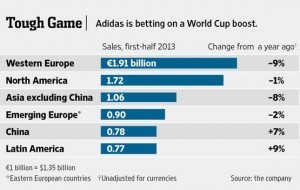
Le grand détaillant de sport, Adidas, se prépare pour la Coupe du monde 2014. Dans sa compétition avec Nike, Adidas a eu beaucoup de difficulté récemment. Nike a dominé les marchés avec 54% de la part de marché aux Etats-Unis (Adidas a 11% de la marché). La Coupe du monde est essentiale pour Adidas parce qu’elle est le leader sur le marché de football (et l’un des sponsors officiels pour la Coupe du monde 2014). Néanmoins, Nike a obtenu beaucoup du marché de football ; en particulier le marché au Brésil. Les investisseurs s’attendent des ventes fortes et ils regarderont attentivement la performance d’Adidas.

De plus, Adidas est le sponsor officiel pour la création du ballon de football pour la Coupe du monde. Il commencera à vendre le ballon, qui s’appelle « Brazuca », dans huit jours et il coute $160. Le prix est incroyable mais Adidas anticipe de vendre plus de 13 millions. Cet exemple montre l’importance du business de la Coupe du monde. En fait, Adidas vient d’étendre son contrat avec le FIFA à 2030. Avec cette extension, le partenariat entre Adidas et FIFA et l’un des plus anciens dans l’histoire (60 ans).
November 21, 2013
2013 Surely has been CR7’s year?
Unlucky Ribery, it looks like a champions league, Bundesliga title and a Pokal Cup will not be enough to help you win the historic Ballon D’Or. After months of trying to figure out should Ribery win the prestigious award as his team won a historic Treble, or was Messi’s end to the 2012/2013 season enough for him to seal it, Cristiano Ronaldo shows up in the clutch scoring two goals in 38 seconds to send his nation to Brazil in 2014.
In addition the news that Fifa has extended the ballot voting period until the end of the month will allow those who want to change there previous decision, which ultimately, cannot be good news for Ribéry either. Ronaldo’s display was one that the football Gods can only dream of, one matched to Messi’s at the Santiago Bernabau in 2012, or Paolo Rossi in the 1982 World Cup final and even Diego Maradona’s touch of class against England. He was simply flawless.
He was taunted and booed by the Swedes the entire night. Every time he touched the ball, dribbled, lost possession or took a ridiculous shot on goal. His performance in Stockholm was one that represents the new Ronaldo, no longer a young arrogant player who when suffering with his feet, takes it out on his teammates, stops passing the ball, and simply beating himself up in the corner of the pitch. He controlled the game on Tuesday, when Portugal was down and required a quick momentum change CR7 was there to make the difference. When Portugal rocked, he refused to allow them to tumble. He continued his impeccable club form on international duty. As Andy Brassell wrote “The scorecard may have read Zlatan 2 Cristiano 3 but the difference was much more appreciable. Ibrahimovic gives hope where there is none. Ronaldo makes the impossible possible.” Moreover, his hat-trick capped tying the all-time scoring charts for Portugal with 47 goals at the young age of 28.
Although I would still agree that so far in his career Messi has been the better of the two, as much as it pains me to say this, 2013 has been Cristiano’s year.
If you wish to watch a great documentary presented on ITV4 (U.K television) last month click here
RONALDO’S INCREDIBLE NUMBERS… by Sam Stevens
66 Ronaldo has scored an incredible 66 goals for club and country in 2013. That includes 56 goals in 46 games for Real Madrid and 10 in nine for Portugal.
8 The 28-year-old is the top scorer in the Champions League this season with eight goals, one ahead of Zlatan Ibrahimovic, and two ahead of Lionel Messi.
1.20 Goals per game ratio for Ronaldo in 2013. And it gets better if you only look at this season. He has 31 goals in 21 appearances in 2013-14. That’s 1.48 goals per game.
16 The Portuguese is also the top scorer in La Liga this season with 16 goals in 13 matches. He already has twice as many as Messi.
47 Ronaldo equalled Pauleta’s national record of 47 goals for Portugal. The forward is closing in on Bobby Charlton and Thierry Henry’s records, but has a way to go before he catches Gerd Muller (68) and Pele (77).
5 Ronaldo has outscored the Premier League’s five biggest clubs in 2013. Liverpool (61), Man City (56), Arsenal (55), Man United (54) and Chelsea (54) have all scored fewer league goals this year than Ronaldo has scored in
all competitions.
225 Since joining Real Madrid, Ronaldo has scored 225 goals in 216 games for the club. In just five years he has already become Madrid’s fifth highest scorer and is closing in on Ferenc Puskas (242, right) in fourth. [1]
[1] Read more: http://www.dailymail.co.uk/sport/football/article-2510768/Cristiano-Ronaldo-best-player-world-ahead-Lionel-Messi-Zlatan-Ibrahimovic-Franck-Ribery.html#ixzz2lDBNSB2j
Follow us: @MailOnline on Twitter | DailyMail on Facebook
[2] Read more: http://www.dailymail.co.uk/sport/football/article-2510768/Cristiano-Ronaldo-best-player-world-ahead-Lionel-Messi-Zlatan-Ibrahimovic-Franck-Ribery.html#ixzz2lDBNSB2j
Follow us: @MailOnline on Twitter | DailyMail on Facebook
November 20, 2013
Two MLS teams in Florida
The MLS has announced its plan to add four new teams, expanding the league to 24 teams by 2020. Is this a bigger push to get more Americans involved in the league? While there are many programs vying for the spots, . With that in mind, it is interesting that David Beckham is working with LeBron James to start an MLS team in Miami.
Is this really a good idea? I am all for expanding the MLS. The NFL has 32 teams, and the NBA, NHL, and MLB all have 30. I think that more teams, spread across the country (except for maybe 2 in a few big cities, like New York or LA) would spark more interest, getting people to come out and support their local teams. But putting two teams so close together? I don’t know about that. Granted, this could work. It works in other football (The Jaguars and the Dolphins) and the Dolphins are one of the best marketed sports teams in history. But will this translate to soccer? I am skeptical, mainly because of Miami’s past experience of failing to rally behind an MLS team. Some will be more optimistic than me, but I just don’t see it happening, even with the ‘Star Power’ behind the James/Beckham combo.
2 MLS teams in Florida
The MLS has announced its plan to add four new teams, expanding the league to 24 teams by 2020. Is this a bigger push to get more Americans involved in the league? While there are many programs vying for the spots, . With that in mind, it is interesting that David Beckham is working with LeBron James to start an MLS team in Miami.
Is this really a good idea? I am all for expanding the MLS. The NFL has 32 teams, and the NBA, NHL, and MLB all have 30. I think that more teams, spread across the country (except for maybe 2 in a few big cities, like New York or LA) would spark more interest, getting people to come out and support their local teams. But putting two teams so close together? I don’t know about that. Granted, this could work. It works in other football (The Jaguars and the Dolphins) and the Dolphins are one of the best marketed sports teams in history. But will this translate to soccer? I am skeptical, mainly because of Miami’s past experience of failing to rally behind an MLS team. Some will be more optimistic than me, but I just don’t see it happening, even with the ‘Star Power’ behind the James/Beckham combo.
November 19, 2013
Brazil 2014: Watch Your Head
Given today’s lecture regarding perceived World Cup host nation issues and media hype, I felt as though a post regarding the likelihood of fan violence during the 2014 World Cup was merited. Brian Phillips at Grantland already did much of the work for me on this topic in his article A Yellow Card, but I will give my take on the matter as well.
Significant impetus for the alarmist mentality many–media outlets and people alike–maintain about violence in Brazil stems from two cases of beheading that have occurred within the past six months. One was likely related to gang violence, while a contentious call, weapons, alcohol and a hoard of loving, if not overly aggressive, family members characterized the other. Without getting too much in the gritty details (Phillips is not so coy), these events are surely tragic and disturbing. Of course these two events also point to a greater trend in Brazil: that beheadings will now take the nation and, since the circumstances are so similar, the World Cup by storm, right? Yes, because that is definitely how statistics/probability works. Instead of relying on an objective, rational judgment, people as a whole will form their opinions based on what they read in the New York Times, CNN, USA Today, etc., who have each done their part in perpetuating these concerns. Can you really blame them for doing so? These are some of the most reputable newspapers in the United States, so it does not seem unfair to place credence in their opinion. Well, it is unfair. Violent crime in Brazil is definitely an issue, like it is in the USA, but I just cannot believe that beheadings, or any heinous crimes for that matter, will come to forefront of the World Cup once it actually starts. Political protests, police ineptitude, corruption, income disparity, and forced evictions of the poor from the favelas are much more important Brazilian contemporary issues of which few are aware relative to the beheadings.
Once the World Cup begins, barring extensive, irresponsible police riot control that could spur more violent protests, I think the motif that has been present since 1930 will reign supreme. Like in South Africa in 2010, when many feared murders and rapes, the better part of the world will momentarily forget about differences, strife, bigotry, fear, violence, anger, and so on for the love of a worldwide game. As we have learned through lectures and other blogs, soccer can be a unifying factor, and there is no event more unifying in the game than the World Cup.
In closing, some statistics: 49,900 people were murdered in Brazil, but almost none of those violent crimes involved foreigners, since those murders are virtually all motivated by intra-Brazilian issues. Robberies and thefts are somewhat of a concern for tourists. For example in 2008, 184 incidents like this were reported in Rio de Janeiro. Since many of these events go unreported, for the sake of argument, let us assume an upper bound of 1000 incidents. 2.82 million people visit Rio every year, therefore, according to this estimate, there was 1 incident for every 2,820 people. The probability of being robbed is strikingly low. Furthermore, these events have occurred in the absence of increased security that will accompany the World Cup. Another way to look at this issue is to consider the number of people in Brazil that play, follow, and bleed soccer–maybe slightly less that their overall population of 198.7 million people. That number alone should inform us that the Brazilians will prioritize soccer above violent beheadings, among other crimes, come summer 2014.
Ultimately, in spite of the media hype and alarm, millions will attend the World Cup in Brazil, and they will have the time of their life doing so.
November 18, 2013
Soccer Potential in India
Being ‘the global game’ it is sometimes surprising why there is no mention of India. They have a hard working, extremely large population in a country that has been expanding through its industrial age. When I visit, I see international jerseys everywhere, so it’s quite true that soccer fans are in number in India. I went to large viewing parties to see Manchester United play at my cousin’s college. I used to go running in the mornings along Juhu beach on the Indian Ocean edge of Maharashtra, and saw small and large sided beach soccer games every time I went. Just like in Brazil or other Latin American countries, you can see youth playing with whatever spherical objects they can find. The love of the game is there, so the question is why isn’t the team there? To say India is not a sporting nation would be a flaw, as they have been a long-standing dominant force in cricket. If British brought cricket to India, why did soccer not bleed into Indian culture in the same way other colonies leeched the sport from their parent countries?
The problem lies in the lack of infrastructure – especially at the youth levels. While I did see many children kicking a ball around and playing small sided games there was never a sense of much organization. They play for fun and as the children get older and older, a lot of the athletes will migrate towards cricket. There is a dearth of good soccer fields, while fine cricket pitches are peppered throughout Mumbai, and I’m sure this rings true for the rest of India. At the end of the day, this makes sense as Indians are crazy about cricket. The national team is one of the proudest icons of India, and the money they make is extraordinary. So it is not uncommon to see the better athletes being funneled into the sport which seems more within reach and it seen on a daily basis. Being a country with a very large impoverished population and a government filled with many corrupt official, the investment is surely going to have to come from the outside, though that may not be too far off.
Manchester United and Liverpool, among other clubs, have decided to take a gamble and reach out to talent in India by offering academies. Man U opened their academy in Delhi and the club is really bringing soccer excitement to the area. Not only is the club providing coaching to the youth by their club’s own youth developers, they also are providing teaching to Indian coaches to help them further the game. Liverpool FC has also made forays into the subcontinent recently opening up their own center in Pune. The facility features pitches, classrooms, a gym, cafeteria, lecture halls, and medical facilities. They too are supplying their own academy coaches seeking to find gems in the Indian talent pool. This is a good venture for both sides, as Liverpool is able to garner many more soccer fans in a cricket crazed country, while the Indian youth are being exposed to top level coaching. India themselves are also investing with the hiring of Dutch coach Robert Baan as the nation’s first technical director. He was previously the director in the Netherlands and Australia and is ambitious, trying to propel India to a future World Cup berth. He is opening residential academies under the All India Football Federation (AIFF), providing free education alongside soccer training. It might be a while until we see notable Indian players pop up, but it is good to see the grassroots foundation has been laid so these players at least have a chance.
In the cricket world, India recently introduced a league to feed the yearning for more cricket – The Indian Premier League (IPL). Its season last less than two months bringing in all the worlds cricket superstars while maintaining a focus on Indian cricket (22/33 of each team’s players must be of Indian nationality). The tournament has brought in immense amounts of money with PepsiCo being a title sponsor. It is this kind of league that the soccer needs in India, and it is now becoming a reality. Billionaires Mukesh Ambani and Rupert Murdoch have joined forces to launch a league to mirror the IPL. This league has also gathered big name sponsors and aims to inspire the youth as well as gain more of an overall soccer following on the national level. Stars (albeit former) such as Thierry Henry and Michael Owen are being courted to play alongside India’s own national stars. Such a league might be the missing piece alongside the new academies to finally bring India to the world soccer stage.
Slavic Rivals: A Brief History
The historically vicious Belgrade derby took place earlier this month on November 2nd. While Red Star clearly dominated the match, the only goal posted during the game was by Partizan defender Milan Obradovic, who accidentally scored on his own keeper with a header in the 18th minute. Partizan fans took home a loss from Red Star, but not before setting fire to the stands of Red Star’s Marakana stadium [1].
Article/Video: http://www.euronews.com/2013/11/04/belgrade-derby-stopped-by-partizan-fans-setting-fire-to-stand/
Three days later, David Goldblatt, author of The Ball is Round: A Global History of Soccer, graced our class with his presence. Goldblatt has traveled the world to research football for his book, and when asked to describe the most memorable and amazing football spectacle he had ever experienced, he immediately stated, “Serbia.” Coincidentally, Goldblatt went on to recount one of the Belgrade derbies he had the fortune of attending, detailing lots of violence, “pyrotechnic” hooligan fans, and ferocious Serbian military police.
As Goldblatt touched upon in class, the Partizan-Red Star rivalry is much more than just sport and friendly competition. Serbia’s Slavic neighbor, Croatia also shares in the fierce rivalry with Serbia, and similarly between its own club teams: Dinamo-Zagreb and Hajduk-Split. Serbian and Croatian football have an intertwined and violent history, which symbolized and even played a role in the tension and fighting before the Yugoslav Wars of the 1990s.
Serbia: Red Star vs. Partizan
For most Serbians, their die-hard allegiances are split between two Belgrade teams, Red Star and Partizan.
Although the quality on show during the ‘Veciti Derbi’ (Eternal Derby) has slipped since the break-up of the former Yugoslavia and the regular exodus of the brightest talents, the rivalry itself has perhaps even intensified to compensate for fan frustrations on a sporting level.
-FIFA Classic Football Rivalries [2]
Red Star’s “Delije” (Heroes) and Partizan’s “Grobari” (Undertakers) were both established in 1945 only a few months apart. Both teams came into existence after WWII by different political entities: Red Star by the Yugoslavian Communist Party and Partizan by the Yugoslav People’s Army. Red Star holds 25 league titles, 24 national cup titles, and 4 international cup titles, while Partizan holds 25 league titles, 12 national cup titles, and 1 international cup title. A power struggle existed between the Ministry of the Interior (Serbian Secret Police) and the Ministry of the Defense in Serbia, fueling this competitive rivalry [2].
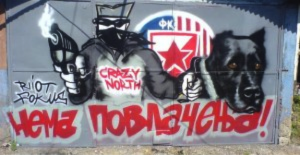
Red Star Street Art, Belgrade, Serbia
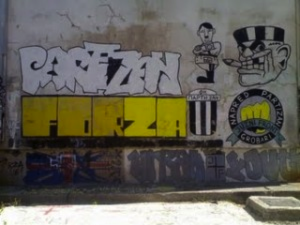
Partizan Street Art, Belgrade, Serbia
Croatia: Dinamo vs. Hajduk
Hajduk-Split, one of Croatia’s premier clubs located on the Adriatic coast, was established in 1911 by four students. Their professor gave them the name “Hajduk” (Insurgents), saying “that which is best in our people: bravery, humanity, friendship, love of freedom, defiance to powers, and protection of the weak. Be worthy of that great name.” [3] Since then, the team has been nicknamed “Champions from the coast,” earning 18 league titles and 21 cup titles.
Dinamo-Zagreb from the north, Hajduk’s rival, was founded following World War II in 1945 when two Zagreb clubs, HASK and Gradanski, merged. Since its establishment, Dinamo has racked up 19 league titles, 24 domestic cup titles, and two international cup titles [4].
According to Croatian sociologist, Dražen Lalić, the rivalry represents the competing forces between the Croatian aristocracies of the north to the “economically devastated, culturally neglected, politically rejected, looted in terms of sports and provincial” of the Southern Coast of Dalmatia. Northern Croatia has been criticized for its “cultural imperialism,” and Dinamo, being from the capital, receives much more funding from the state than Hajduk. The tensions between the two teams result in rowdy and violent matches, but also altercations between fans and even civilians [5].
Croats with Dalmatian license plates (Zadar, Split, etc) keep an eye on their cars in the north, particularly in Zagreb. My Dalmatian friend keeps Dinamo Zagreb fans, aka the “Bad Blue Boys,” off his car by displaying their team’s merchandise on his dash, most notably a pennant depicting a bulldog (the symbol of the Bad Blue Boys) ripping apart a Dalmatian dog.
-Ivan, Croatian Soccer Fan
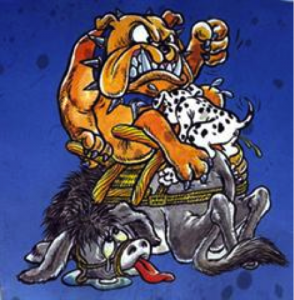
Graphic Dinamo Fan Art
Era of the “Big Four”
There exists a clear distinction for both Serbia and Croatia in football before and after 1991. Prior to 1991, there persisted four major clubs in Yugoslavia called the “Big Four”: Dinamo-Zagreb, Hajduk-Split, Partizan-Belgrade, and Red Star-Belgrade (as you probably guessed) [6].
Ethnic tensions between the Serbs and Croats escalated after the death of Yugoslavian President, Josip Broz Tito in 1980. Tito successfully appeased both nations, keeping Yugoslavia relatively peaceful, and avoiding the pre-1974 Serbian hegemony. Unfortunately, Serbian dominance in Yugoslavian politics returned with the help of Serbian politician Slobodan Milošević [7].
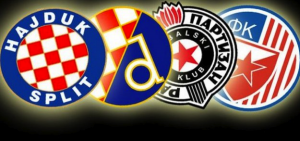
The “Big Four”
Hajduk, Dinamo, Partizan, Red Star
Derbies within republics (Dinamo vs. Hajduk, Red Star vs. Partizan), reflected a time of less violence. In Croatia, the Eternal Derby between Dinamo and Hajduk was especially important, as it represented the opportunity to show Croatian pride over Yugoslavian pride. Both Dinamo and Hajduk fans felt that Serbian teams were their suppressors and true rivals. Croatian fans left derbies with a sense of national pride and brotherhood, regardless of the match outcome [6].
The growing tensions between Croatia and Serbia reached a climax on May 13, 1990 at Maksimir stadium in Zagreb during a match between Dinamo and Red Star. Two weeks prior to the match, the Croatian Democratic Union had their first free parliamentary elections, directly opposing Serbia and Milošević’s communist Yugoslavia [6].
Red Star fans were brought to Zagreb for the match under fan leader, Željko “Arkan” Ražnatović. Hours before the game, fights had already broken out in the streets of Zagreb between Dinamo (Bad Blue Boys) and Red Star (Delije) fans. The violence carried over into the start of the game, where Delije began to destroy the stadium. When the Bad Blue Boys attempted to fight back, Serbian regime police at the match selectively chased and charged Croatian supporters.
Dinamo captain, Zvonimir Boban, after watching a police officer beat a Dinamo fan with his bat, jumped onto the officer, delivering a historical “kun-fu-style” kick, knocking him down and allowing the fan to escape.
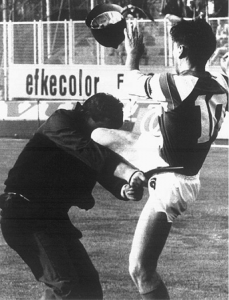
Boban’s Mighty Kick
“The War Started In Maksimir”
That day summed up all the bad side of Yugoslav politics that was present for 50 years, the unfairness to Croatian people, the injustice. … When our fans wanted to protect our stadium, our home, our Zagreb, Dinamo, and Croatia, the police acted in an incredibly drastic and aggressive way. They started to beat up the fans to crush them.
-Zvonimir Boban, former Dinamo Midfielder [6]
Boban’s kick became legendary, and the Dinamo Zagreb-Red Star Belgrade riot of 1990 became symbolic of the Croatian nationalism and discontent with Yugoslavian politics. Many believe the riot sparked the Croatian War of Independence that began a year and a half later, claiming “the war started in Maksimir.”
Serbia’s role as the pride of Yugoslavia was solidified in 1991 when Red Star won the European Champion Clubs’ Cup, the greatest success in Yugoslav football history. While the accomplishment represented the country as a whole, it was celebrated as a Serbian triumph, and further “[stoked] the flames for ethnic nationalism” [8].
As tensions and conflict loomed, football fans became soldiers. Many Croatian football fan groups joined the Croatian army. Arkan’s fan group, the Delije, eventually became a paramilitary group called the “Serb Volunteer Guard” and eventually “the Tigers.” The Tigers would go on to commit various war crimes, including murder and rape.
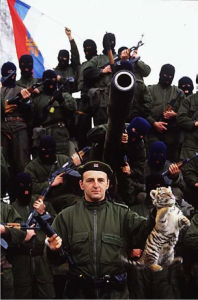
Željko “Arkan” Ražnatović
The Tigers
Post-Conflict
To this day, Serbian and Croatian fans are known to take their responsibilities as football supporters very seriously. In a match against Italy in 2010, Serbian fans threw flares on the pitch. The game was abandoned after seven minutes, resulting in a 3-0 loss to the Italians [9]. In 2012, Croatian fans exhibited severe racism against Italian player, Mario Balotelli with racist chants [10] and banana (and flare) throwing on the pitch [11]. The Croatian football association sustained a hefty $100,000 fine from the UEFA.
The World Cup Qualifying matches this year turned out to be the first time Croatian and Serbian national teams played head-to-head since 1999. The first qualifying match in March of 2013 took place in the historical Maksimir stadium, with high anticipation for violence. Authorities from both countries agreed to keep visiting fans away, and no major issues arose. Croatian fans, however, were “unable to resist the urge to chant things like ‘Ubij, ubij Srbina’ (‘kill a Serb’) during the encounter” [12].
The first match in March resulted in a 2-0 win for Croatia, and a draw in Belgrade in September. Croatia is still in the running for World Cup Qualification, playing Iceland tomorrow, November 19th!
References:
[1] http://asia.eurosport.com/football/european-football/2013/red-star-beat-partizan-in-troubled-belgrade-derby_sto3990724/story.shtml
[2] http://www.fifa.com/classicfootball/clubs/rivalries/newsid=1206159/index.html
[3] http://www.gfdb.com/Club.1646.Hajduk-Split.aspx
[4] http://www.fifa.com/classicfootball/clubs/rivalries/newsid=112078/index.html
[5] http://croatiantimes.com/?id=21570-newentry
[6] http://www.youtube.com/watch?v=j8azzIOmhzU&list=PLpSTSVIjB0PUHUN8SKUy74G-daxKsIBix
[7] http://vlib.iue.it/history/europe/yugoslavia.html
[8] http://www.opendemocracy.net/can-europe-make-it/ivan-djordjevic/red-star-serbia-never-yugoslavia-football-politics-and-national-i
[9] http://www.theguardian.com/football/2010/oct/12/italy-serbia-called-off-crowd-trouble
[10] http://www.nydailynews.com/sports/euro-2012/euro-2012-uefa-fines-croatia-football-association-100-000-fans-racially-abused-italy-mario-balotelli-article-1.1098413
[11] http://www.dailymail.co.uk/sport/euro2012/article-2159847/Euro-2012-UEFA-investigate-banana-thrown-pitch-Italy-v-Croatia.html
[12] http://www.dw.de/croatia-beats-serbia-2-0-in-no-ordinary-game/a-16694684
November 17, 2013
Bubble Football
First, I’d like to say that even if you can’t read French this video is worth watching because this sport is hysterical and should be played everywhere and by everyone.
Règles du jeu: 14 joueurs sont enfermés dans des bulles gonflables et sont encouragés à rebondir une dans l’autre quand ils se battent pour la possession de la balle. Deux équipes de sept joueurs sont chacun habillé dans les sphères en plastique avant de courir et tapé dans le ballon.
Bubble Football est un nouveau jeu qui est très drôle où les joueurs de foot jouent à l’intérieur de costumes gonflables de rebond. Ce jeu a été créé par Lee Moseley au Royaume-Uni. Ce nouveau type de football réunit un tout nouveau sens au contrôle de la balle parce que les joueurs s’affrontent à l’intérieur de ces bulles géantes. Le jeu peut coûter jusqu’à £ 400 pour toute la journée avec 14 costumes de bulles. Mais ce jeu est très en demande et un tournoi géant avec 34 équipes aura lieu en Décembre. Les investisseurs qui n’avaient pas vu le potentiel du produit initialement ont refusé Lee. Le fanatique de football a financé le jeu entier avec le soutien de son épouse. Le sport peut maintenant être trouvé à travers le Royaume-Uni.
Lee a dit: « Je pense que la première fois que vous jouez, vous êtes un peu inquiet. On va seulement penser que ça va mal quand quelqu’un vous frapper et vous pousser. » Il dit aussi que les costumes de bulles sont très sûrs même si nous voyons que les bulles retournèrent et frappèrent facilement sur leur dos comme les tortues. Apparemment il ne fait pas mal du tout parce que vous êtes dans cette bulle et si vous tombez correctement vous pouvez rebondir tout de suite sur vos pieds. Une des parties les plus difficiles de se remettre en place, c’est parce que vous vous moquez beaucoup d’autres personnes. « Il y a eu des moments différents où cinq personnes sont impliquées dans rebondissant sur l’autre, les gens sont coincés sur leurs têtes où les bulles ont restés à l’envers, son hilarants … Il change vraiment le jeu parce que vous ne pouvez pas établir le contact avec les pieds des gens quand vous arrivez d’abord à la balle, donc vous devez frapper les gens à la place.”
Comme le football régulier peut devenir très intense, Bubble Football est censé être plus allègre et drôle. Les règles ont tendance à être beaucoup plus détendu et les gens puissent vraiment s’amuser et apprécier le jeu. Tout le monde devrait l’essayer.
Deux Perceptions en concurrence de l’immigration en France
J’ai bien apprécié l’autobiographie de Lilian Thuram que les étudiants francophones ont lu la semaine dernière, et je veux ici élaborer sur mon commentaire du 7 novembre. L’autobiographie est un texte d’espoir, un texte qui démontre la possibilité illimitée qui existe en France. Sans doute, Thuram reconnaît qu’il existe certains problèmes et tensions qui tourmentent la banlieue. Toutefois, Thuram conclut que la banlieue est surtout un endroit positif qui est caractérisé par une richesse culturelle, linguistique, et ethnique. C’est très intéressant de contraster cette expérience de Thuram avec celle de Salie, la protagoniste de Le Ventre de l’Atlantique, un livre de Fatou Diome que la section francophone a lu il y a quelques semaines.
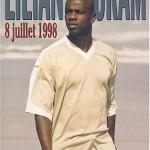
8 juillet 1998, l’autobiographie de Lilian Thuram.
Lilian Thuram immigre en France avec sa mère et sa fratrie. Il identifie un manque de compréhension entre des groupes ethniques dans la banlieue qui résulte d’un manque d’espaces communs. Il lamente aussi le fait que les résidents perçoivent souvent une « frontière invisible » (37) entre leurs quartiers et les autres quartiers de la société, qui contribue à une division artificielle qui crée de la suspicion mutuelle. Thuram remarque que les tensions sont accentuées parce que beaucoup de Français qui habitent hors de la banlieue ont des préjugés contre les banlieusards ; ils supposent que les banlieusards sont obligatoirement pauvres et violents. Les tensions déstabilisent la société en créant une méfiance mutuelle alimentée par le racisme et la xénophobie.
Toutefois, malgré tout ces problèmes de la banlieue, Thuram suggère que la vie dans la banlieue est surtout un expérience riche. Comme enfant, Thuram appréciait beaucoup la diversité de son quartier à Fougères, qu’il appel un “kaléidoscope ethnique” (35). Thuram se souvient le multiculturalisme de ses amis enfantins, et son intérêt pour leurs cultures, leurs langues, et leurs patries. Les matches de foot permettaient aux amis de Thuram de développer des relations respectueuses, sans égard pour la race, le statut socio-économique, ou le pays d’origine.
Diome peint une image opposée de la banlieue. Le personnage principal de sa livre, Salie, immigre en France du Sénégal pour essayer de gagner de l’argent pour améliorer sa vie et celle de sa famille. Nombreux Sénégalais croient que « Chaque miette de vie doit server à conquérir la dignité » (30), et ils pensent souvent que la vie en France est glamoureuse et que c’est assez facile d’y gagner une fortune. Les garçons sénégalais sont particulièrement éblouis par la France, et ils perçoivent le football d’être un raccourci à la richesse. Toutefois, la vie de Salie n’est pas la vie de star, et la France n’est pas un paradis pour des immigrés. A cause de sa pauvreté, son statut comme immigré, et son ethnicité, Salie trouve que sa vie en France est dure. Elle regrette que « En Europe…vous êtes d’abords noirs, accessoirement citoyens, définitivement étrangers, et ça, ce n’est pas écrit dans la Constitution, mais certains le lisent sur votre peau » (176). Par conséquent, Salie cherche à dissuader son frère de venir en France. Diome suggère que c’est possible d’avoir une vie épanouissante au Sénégal et que ce chemin est préférable à l’émigration.

Le Ventre de l’Atlantique, un roman de Fatou Diome.
L’incompatibilité des deux perceptions de l’immigration est frappante. C’est évident que Thuram et Diome ont des rapports très différents avec la France et que la France la signification de la France n’est pas le même pour tout le monde. L’immigration et la banlieue, la destination de beaucoup d’immigrés, sont complexes. Thuram identifie des vrais avantages de la vie dans la banlieue malgré tous les problèmes qui y existent. En même temps, il faut reconnaître que Thuram a atteindre plus de richesse et célébrité que la grande majorité d’immigrés. Par conséquent, sa perception de la possibilité qui existe dans la banlieue n’est pas nécessairement comparable à celle de beaucoup d’autres immigrés, come Salie. Malgré des rêves des garçons sénégalais d’être comme Thuram, son niveau de réussite est extrêmement difficile à atteindre.
November 16, 2013
Changing the College Soccer System
In the debate on how to best achieve the first World Cup title for the United States, the differences between how youth are filtered into professional leagues in the U.S. verses other nations who have had World Cup success is often the main topic of conversation. All other national programs outside of the U.S. have youngsters who dedicate the majority of their time to honing their footballing technique essentially from the onset of puberty. For this to happen in the U.S., it has often been said that education would have to take a backseat to training and preparing for the professional world mainly through bypassing the college system all together [2]. This type of approach would be going against the current trend in the sporting world, as a majority professional sports (basketball, football) have passed rules that require at least a year in college before it is possible to move on to the professional leagues.
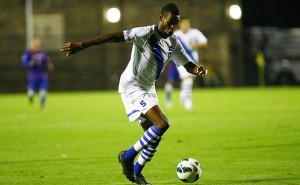
Photo from dukechronicle.com
However, some have denied that the approach to soccer success in the United States needs to be all-or-nothing in doing away with the college-level game, and instead suggested that America can even have an advantage over the rest of the world in containing an additional avenue to success offered by the college system. A possible compromise would be to encourage potential professional players to get involved with MLS academy team while still playing at their respective universities [1]. This solution could allow for a vitally important rigorous schedule while also lessening the harmful bottlenecking effects that exist in nearly every other successful national team and league when 99% of the talent pool doesn’t make it on the professional level. In this hybrid system, all the positives of the college system remain as players would have more to fall back on in terms of education and other career opportunities in comparison to nations like Brazil or England, while allowing the best players to be given access to the top training facilities and programs available.
Additionally, this would fix many of the problems within the college game itself. Many critics of the college system have said that the type of soccer played at this level is too slow, too direct, and too physical to thrive on the national stage [1,2]. The unlimited amount of substitutions is typically cited as the main reason for this, as an endless supply of rested legs can be dumped on to the field in order to sustain a type of play that favors chasing the ball instead of possessing it. With the increase amount of proper training and game time experience where the actual rules of soccer are used, players could get the type of training and preparation they need to succeed on the global stage. Furthermore, the low number of games played year-round in the current setup would be injected with many more MLS academy games, most likely against better competition. Collegiate players could use the additional playing opportunities to fill the large amount of downtime in the college soccer schedule from December to February and in the summer months.
Also, this would eliminate the competition between universities and professional clubs for the soccer talent pool in America. While a child prodigy would still be able to forgo college all together to work exclusively with a professional club around the clock, a player who shows great potential but may not be as sure-set on a professional career wouldn’t have to make such a huge life decision so soon. Rather, this player could attend a university and have 4 more years to develop and decide whether the professional athlete track is really meant for them. This secondary option is extremely beneficial to the overall talent pool available for the national team to draw upon. The college system is phenomenal in the amount of opportunities it gives its players to develop and shine, especially for the type of “late-bloomer” player who may need a few more years to incubate in order to be ready for the next level. There are much more places to play across the three college divisions than in one or maybe two divisions in professional leagues. You also get 4 years to show that you are worthy of the next level, instead of a tryout period that can last only months in a professional environment. In this way, colleges provide a kind of “back-door” into the professional and national team setup that could aide greatly in catching talent missed at earlier stages [1].
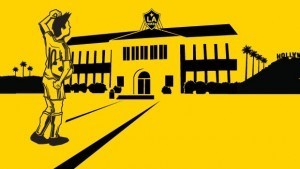
Gabriel de los Rios/MLSsoccer.com
Lastly, and maybe most importantly to American soccer, this option provides the greatest opportunity for Americans to forge an intimate connection with a soccer team by preserving the collegiate system [3]. University teams are virtually the only organizations that can provide the ties to the surrounding community necessary for the development of a deep connection with a team. In improving the level of training given to collegiate players and still allowing them to be nestled in a community which will readily support them, maybe American soccer fans can have their cake and eat it too.
References:
[1] Fox Soccer Exclusive. The Future of College Soccer. Four-part series by Leander Schaerlaeckens. Accessed on November 16th, 2013. http://msn.foxsports.com/foxsoccer/us...
[2] Examiner.com. Does college soccer hurt the US National Team? Mike Burke. Accessed on November 16th, 2013. http://www.examiner.com/article/does-college-soccer-hurt-the-us-national-team
[3] Pitch Invasion. In defense of American college soccer: a community perspective. Andrew Guest. Accessed on November 16th, 2013. http://pitchinvasion.net/blog/2009/08/31/in-defense-of-american-college-soccer-a-community-perspective/
Laurent Dubois's Blog
- Laurent Dubois's profile
- 44 followers


